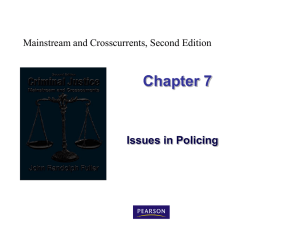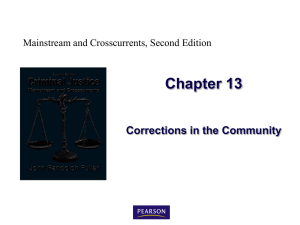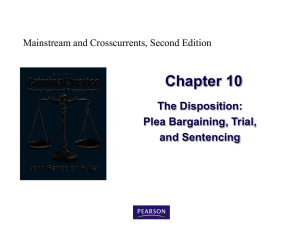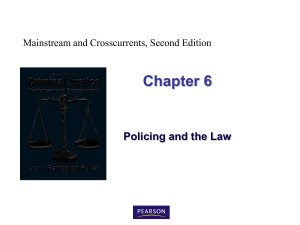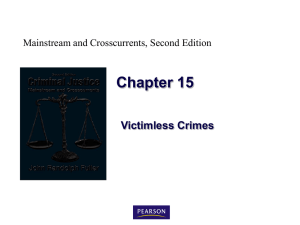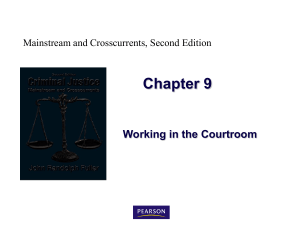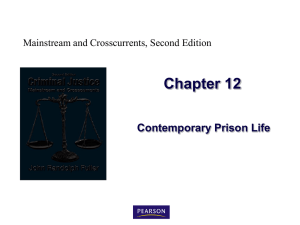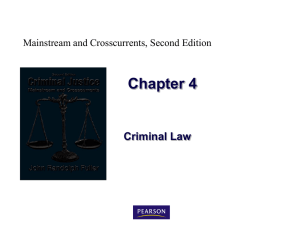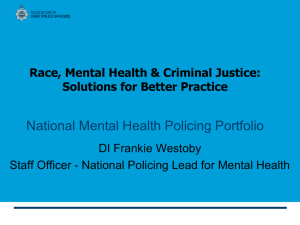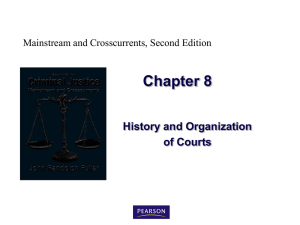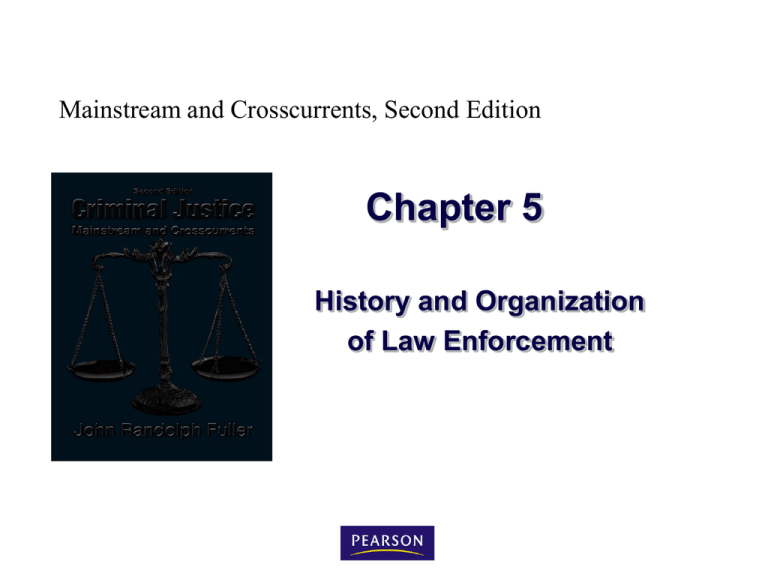
Mainstream and Crosscurrents, Second Edition
Chapter 5
History and Organization
of Law Enforcement
A brief history of the police
Police in early England
The form of policing that most directly led
to that of modern US policing was
England's frankpledge system.
Criminal Justice: Mainstream and Crosscurrents, 2/e
John Randolph Fuller
2
© 2010 Pearson Higher Education,
Upper Saddle River, NJ 07458. • All Rights Reserved.
A brief history of the police
Police in early England
The invention of gin advanced the
development of law enforcement by
making hard liquor affordable for many
people.
Criminal Justice: Mainstream and Crosscurrents, 2/e
John Randolph Fuller
3
© 2010 Pearson Higher Education,
Upper Saddle River, NJ 07458. • All Rights Reserved.
A brief history of the police
Police in early England
Henry Fielding organized the Bow Street
Runners, which was more centralized
than the watch-and-ward system.
Criminal Justice: Mainstream and Crosscurrents, 2/e
John Randolph Fuller
4
© 2010 Pearson Higher Education,
Upper Saddle River, NJ 07458. • All Rights Reserved.
A brief history of the police
Police in early England
In 1798, the West India Trading Company
created London's first professional,
salaried police force, the Thames River
Police.
Criminal Justice: Mainstream and Crosscurrents, 2/e
John Randolph Fuller
5
© 2010 Pearson Higher Education,
Upper Saddle River, NJ 07458. • All Rights Reserved.
A brief history of the police
Police in early England
In 1829, Sir Robert Peel sponsored the
Metropolitan Police Act, the first
successful bill to create a permanent,
public police force.
Criminal Justice: Mainstream and Crosscurrents, 2/e
John Randolph Fuller
6
© 2010 Pearson Higher Education,
Upper Saddle River, NJ 07458. • All Rights Reserved.
A brief history of the police
Police in early England
English policing contributed three features to US
policing…
Limited police authority
Local control
A fragmented system
Criminal Justice: Mainstream and Crosscurrents, 2/e
John Randolph Fuller
7
© 2010 Pearson Higher Education,
Upper Saddle River, NJ 07458. • All Rights Reserved.
The 19th century
Policing in the United States
Informal policing began in New York
City in 1625.
The city's first professional police force
was organized in 1845.
Criminal Justice: Mainstream and Crosscurrents, 2/e
John Randolph Fuller
8
© 2010 Pearson Higher Education,
Upper Saddle River, NJ 07458. • All Rights Reserved.
The 19th century
Policing in the United States
The authority of officers in London rested
on discretion granted by the government.
New York City officers had more
discretion, with a personal basis for
authority.
Criminal Justice: Mainstream and Crosscurrents, 2/e
John Randolph Fuller
9
© 2010 Pearson Higher Education,
Upper Saddle River, NJ 07458. • All Rights Reserved.
The 19th century
Policing in the United States
Chicago's official police force was
created around 1855, and reorganized
several times until 1913.
Chicago police had four particular
orientations toward the law…
Criminal Justice: Mainstream and Crosscurrents, 2/e
John Randolph Fuller
10
© 2010 Pearson Higher Education,
Upper Saddle River, NJ 07458. • All Rights Reserved.
The 19th century
Policing in the United States
Chicago police and courts were highly
decentralized.
Chicago police were at the command of
local organizations.
Chicago criminal justice institutions
developed informal systems of operation.
Chicago criminal justice institutions operated
as rackets.
Criminal Justice: Mainstream and Crosscurrents, 2/e
John Randolph Fuller
11
© 2010 Pearson Higher Education,
Upper Saddle River, NJ 07458. • All Rights Reserved.
The 19th century
Policing in the United States
The vigilante tradition was part of
American life, especially in the South and
West.
Criminal Justice: Mainstream and Crosscurrents, 2/e
John Randolph Fuller
12
© 2010 Pearson Higher Education,
Upper Saddle River, NJ 07458. • All Rights Reserved.
Introduction of police professionalism
Reformers & Reform Efforts
The Pendleton Civil Service Act of 1883
The Wickersham Commission & August
Vollmer
Orlando Wilson
J. Edgar Hoover
Criminal Justice: Mainstream and Crosscurrents, 2/e
John Randolph Fuller
13
© 2010 Pearson Higher Education,
Upper Saddle River, NJ 07458. • All Rights Reserved.
Introduction of police professionalism
Reformers & Reform Efforts
The 1883 Pendleton Civil Service Act
basically formed a civil service system
that dispensed with patronage and
administered employment and promotions
based on merit rather than political
connections.
Criminal Justice: Mainstream and Crosscurrents, 2/e
John Randolph Fuller
14
© 2010 Pearson Higher Education,
Upper Saddle River, NJ 07458. • All Rights Reserved.
Introduction of police professionalism
Reformers & Reform Efforts
In 1931, August Vollmer wrote the
Wickersham Commission report that
affected police reform for the rest of the
20th century. Features of the progressive
movement included an emphasis on
technology.
Criminal Justice: Mainstream and Crosscurrents, 2/e
John Randolph Fuller
15
© 2010 Pearson Higher Education,
Upper Saddle River, NJ 07458. • All Rights Reserved.
Introduction of police professionalism
Reformers & Reform Efforts
Orlando W. Wilson increased police
efficiency by assigning officers based on
the amount of reported crime and calls for
service.
Criminal Justice: Mainstream and Crosscurrents, 2/e
John Randolph Fuller
16
© 2010 Pearson Higher Education,
Upper Saddle River, NJ 07458. • All Rights Reserved.
Introduction of police professionalism
Reformers & Reform Efforts
J. Edgar Hoover championed police
professionalism and built the FBI into one
of the premier law enforcement agencies
in the world.
Criminal Justice: Mainstream and Crosscurrents, 2/e
John Randolph Fuller
17
© 2010 Pearson Higher Education,
Upper Saddle River, NJ 07458. • All Rights Reserved.
CrossCurrents A brief history of the police
Frontier justice
As pioneers flooded into the West seeking
land, economic opportunities, or distance
from government, the frontier outgrew the
ability of the country to formally police it.
Criminal Justice: Mainstream and Crosscurrents, 2/e
John Randolph Fuller
18
© 2010 Pearson Higher Education,
Upper Saddle River, NJ 07458. • All Rights Reserved.
Modern police organization
Police department organization
varies little.
Most have uniforms, ranks,
hierarchical chains of command, and
centralized decision-making.
Criminal Justice: Mainstream and Crosscurrents, 2/e
John Randolph Fuller
19
© 2010 Pearson Higher Education,
Upper Saddle River, NJ 07458. • All Rights Reserved.
Modern Police Organization
Crucial differences between the police and
the military…
Discretion
Visibility
Authority
Criminal Justice: Mainstream and Crosscurrents, 2/e
John Randolph Fuller
20
© 2010 Pearson Higher Education,
Upper Saddle River, NJ 07458. • All Rights Reserved.
Modern Police Organization
Problem of Jurisdiction
What has been sacrificed in coordination
and efficiency has been gained in
responsiveness and accountability
Policing is fragmented
More than 18,000 agencies nationwide
Criminal Justice: Mainstream and Crosscurrents, 2/e
John Randolph Fuller
21
© 2010 Pearson Higher Education,
Upper Saddle River, NJ 07458. • All Rights Reserved.
Levels of law enforcement
Federal level
State level
Local level
Criminal Justice: Mainstream and Crosscurrents, 2/e
John Randolph Fuller
22
© 2010 Pearson Higher Education,
Upper Saddle River, NJ 07458. • All Rights Reserved.
Levels of law enforcement
Federal level
Agencies have nationwide jurisdiction, but
concentrate on specific crimes.
About 60 federal law enforcement
agencies are organized under the…
Department of Justice
Department of the Treasury
Department of Homeland Security
Criminal Justice: Mainstream and Crosscurrents, 2/e
John Randolph Fuller
23
© 2010 Pearson Higher Education,
Upper Saddle River, NJ 07458. • All Rights Reserved.
Levels of law enforcement
Federal level
Federal Bureau of Investigation
Nationwide jurisdiction to combat federal
crimes.
Secret Service
Placed under Homeland Security, its
mission has been expanded to include
terrorism.
Criminal Justice: Mainstream and Crosscurrents, 2/e
John Randolph Fuller
24
© 2010 Pearson Higher Education,
Upper Saddle River, NJ 07458. • All Rights Reserved.
Levels of law enforcement
State level
There are many variations in agency
organization from state to state.
State industry or culture can determine the
type of state police agencies.
Many states have bureaus of investigation.
Criminal Justice: Mainstream and Crosscurrents, 2/e
John Randolph Fuller
25
© 2010 Pearson Higher Education,
Upper Saddle River, NJ 07458. • All Rights Reserved.
Levels of law enforcement
State level
Many states have organized their state
law enforcement functions under their
highway patrols.
All states have a highway patrol, except
for Hawaii.
Criminal Justice: Mainstream and Crosscurrents, 2/e
John Randolph Fuller
26
© 2010 Pearson Higher Education,
Upper Saddle River, NJ 07458. • All Rights Reserved.
Levels of law enforcement
Local level
Local law enforcement agencies handle most
crime.
Most local police forces are operated by
municipalities.
About 13,000 local police departments in the
United States.
The largest is the New York City Police
Department.
Criminal Justice: Mainstream and Crosscurrents, 2/e
John Randolph Fuller
27
© 2010 Pearson Higher Education,
Upper Saddle River, NJ 07458. • All Rights Reserved.
Levels of law enforcement
Local level
Criminal Justice: Mainstream and Crosscurrents, 2/e
John Randolph Fuller
28
© 2010 Pearson Higher Education,
Upper Saddle River, NJ 07458. • All Rights Reserved.
Levels of law enforcement
Local level
Sheriff's offices are the most common form of
county law enforcement in the US, with about
3,100 offices.
Most sheriffs are elected.
Most offices run at least one jail.
Criminal Justice: Mainstream and Crosscurrents, 2/e
John Randolph Fuller
29
© 2010 Pearson Higher Education,
Upper Saddle River, NJ 07458. • All Rights Reserved.
Innovations in Policing
Innovations in policing come from three
sources:
Social and technological changes
Research
New ideas.
Criminal Justice: Mainstream and Crosscurrents, 2/e
John Randolph Fuller
30
© 2010 Pearson Higher Education,
Upper Saddle River, NJ 07458. • All Rights Reserved.
Innovations in Policing
Social and Technological Changes
Homeland security
Less-than-lethal weapons
Information technology
DNA databases
Crime mapping
Criminal Justice: Mainstream and Crosscurrents, 2/e
John Randolph Fuller
31
© 2010 Pearson Higher Education,
Upper Saddle River, NJ 07458. • All Rights Reserved.
Innovations in Policing: Social and Technological Changes
Homeland Security
Role expansion
Racial and ethnic profiling
Immigration enforcement
Personnel shortages
Criminal Justice: Mainstream and Crosscurrents, 2/e
John Randolph Fuller
32
© 2010 Pearson Higher Education,
Upper Saddle River, NJ 07458. • All Rights Reserved.
Innovations in Policing: Social and Technological Changes
Less-than-lethal Weapons
Weapons that are not intended
to kill
Protect police
Potential for misuse
Criminal Justice: Mainstream and Crosscurrents, 2/e
John Randolph Fuller
33
© 2010 Pearson Higher Education,
Upper Saddle River, NJ 07458. • All Rights Reserved.
Innovations in Policing: Social and Technological Changes
Information Technology
DNA databases
NDIS
CODIS
Crime mapping
Geographic maps of where criminal
offenses occur and where suspects and
offenders live
Criminal Justice: Mainstream and Crosscurrents, 2/e
John Randolph Fuller
34
© 2010 Pearson Higher Education,
Upper Saddle River, NJ 07458. • All Rights Reserved.
Innovations in policing
Innovations from Research
Kansas City Preventive Patrol
Experiment
Rand Study of Detectives
The DARE program
Project Ceasefire
Criminal Justice: Mainstream and Crosscurrents, 2/e
John Randolph Fuller
35
© 2010 Pearson Higher Education,
Upper Saddle River, NJ 07458. • All Rights Reserved.
Innovations in Policing: Research
Kansas City Preventive Patrol Experiment
Examined the effectiveness of police
patrol
Decreasing or increasing routine patrols
had no effect on crime citizen fear of
crime, or community attitudes toward the
police.
Criminal Justice: Mainstream and Crosscurrents, 2/e
John Randolph Fuller
36
© 2010 Pearson Higher Education,
Upper Saddle River, NJ 07458. • All Rights Reserved.
Innovations in Policing: Research
Rand Study of Detectives
Examined how effective detectives are in
solving crimes.
Suggested that a rethinking about the
duties of detectives warrants new ways of
doing investigative work.
Criminal Justice: Mainstream and Crosscurrents, 2/e
John Randolph Fuller
37
© 2010 Pearson Higher Education,
Upper Saddle River, NJ 07458. • All Rights Reserved.
Innovations in Policing: Research
DARE
The Drug Abuse Resistance Education
program was started 1983 by the LAPD
and Los Angeles schools.
Recent evaluations suggest the program
does little to prevent children from using
drugs.
Criminal Justice: Mainstream and Crosscurrents, 2/e
John Randolph Fuller
38
© 2010 Pearson Higher Education,
Upper Saddle River, NJ 07458. • All Rights Reserved.
Innovations in Policing: Research
Project Ceasefire
Part of the Boston Gun Project
An effort to stem youth violence
Youths were informed that further
violence would not be tolerated.
Criminal Justice: Mainstream and Crosscurrents, 2/e
John Randolph Fuller
39
© 2010 Pearson Higher Education,
Upper Saddle River, NJ 07458. • All Rights Reserved.
Questions
Why is Miranda v. Arizona important?
How are the police different from the
military?
Which level of law enforcement agency
handles most of the nation’s crime?
How has the focus on terrorism changed
US law enforcement?
Criminal Justice: Mainstream and Crosscurrents, 2/e
John Randolph Fuller
40
© 2010 Pearson Higher Education,
Upper Saddle River, NJ 07458. • All Rights Reserved.

